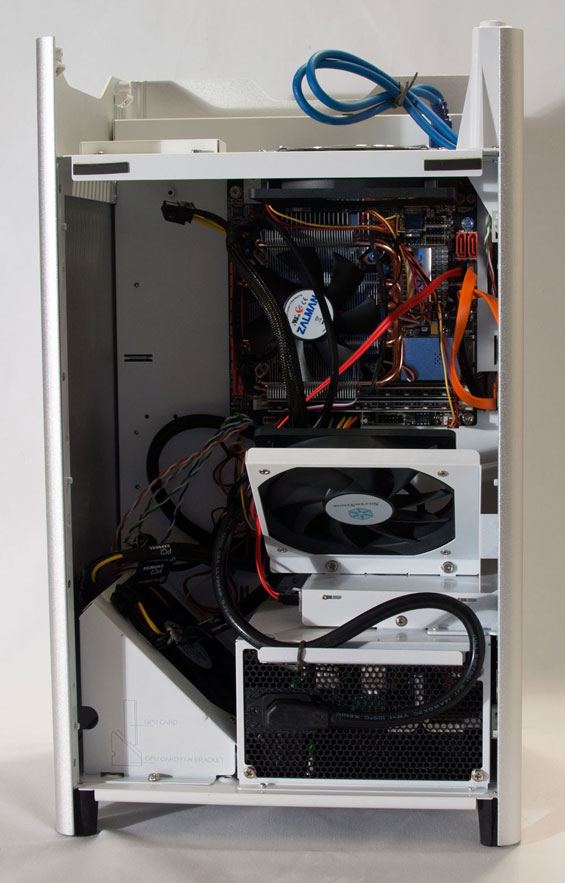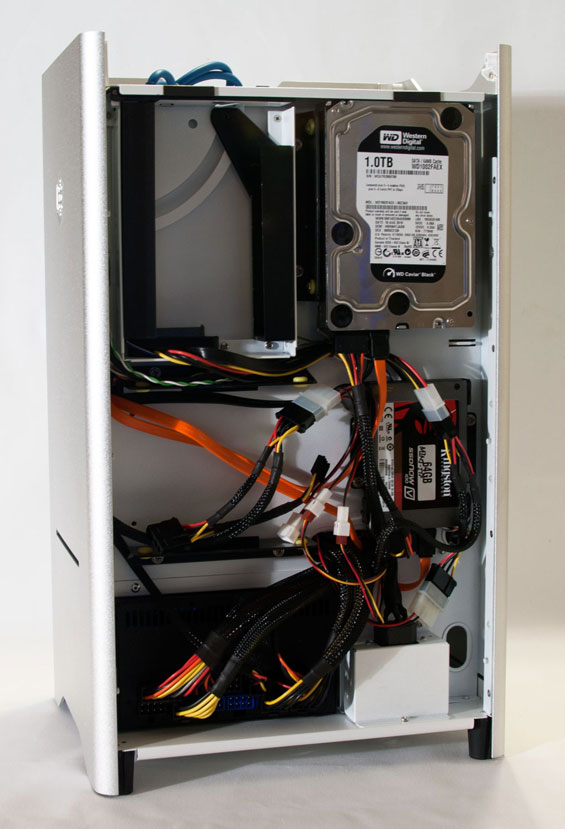SilverStone FT03: Nothing Else Like It
by Dustin Sklavos on April 28, 2011 12:25 AM EST- Posted in
- Cases/Cooling/PSUs
- SilverStone
Assembling the FT03
While most enclosures based on traditional design principles are pretty easy to figure out just by eyeballing them, SilverStone includes an instruction manual with the FT03 for a reason. Much like the GD04 we reviewed before it, there's a specific order you'll want to put the FT03 together in, but thankfully the order at least makes sense and the assembly is as painless as possible.
With this review we're experimenting a little and I've added something different. Below is a time-lapsed video of my scrawny, hairy Greek arms assembling our testbed inside the FT03 set to Chu Ishikawa's music for Tetsuo: The Bullet Man. We know video isn't for everybody (I personally like listening to music while I read reviews so something like this isn't necessarily my cup of tea), but it should be illuminating for those of you who want to get a good feel for how the FT03 gets put together.
The basic assembly of the FT03 involves removing the two intake fans and the extra fan mount at the top first, and the computer gets built essentially from the ground up. Mounting the motherboard is easy enough given the surprisingly copious space inside the case, with standoffs for at least a Mini-ITX board already built into the backplane. What's interesting is that while SilverStone recommends removing the case fans first and indeed that's what I did, it doesn't seem to be strictly necessary (at least removing the bottom one isn't). This isn't a toolless design by any stretch of the imagination, and the tiny screws used for securing the optical drive are pretty easy to lose, but it's as simple as it could be.

Installing the power supply is incredibly simple, too, although the plug used to route to the power supply (thus depriving you of access of the master switch) can have a tendency to bunch and get in the way of sliding the side panel back on.
Where I was really impressed was with the way hard drives are installed; the drive mounting standoffs actually glide into place on the case instead of making you hunt and carefully line up screws. I was admittedly a little puzzled initially with how to install the 2.5" drive tray (though that may have been 1am talking to me), but eventually it locked in exactly where it ought to go. You'll want to install the 2.5" drive with the connectors facing down towards the bottom of the case; the 3.5" drives can't be installed in any orientation other than with their connectors facing inward and down, thus helping with cable routing.

Routing cables is also handled about as well as it can be, but woe betide anyone who tries to install a non-modular power supply in this case. While it can probably be done, routing space for cables is at a premium in the FT03. There are pretty specific places the cables are supposed to route through and I found they worked as well as they could. While you can use a PSU from any vendor, if you're planning on building in this case it might be wise to cough up for a SilverStone Strider power supply specifically so you can buy short modular cables specifically designed to fit inside this case.
Honestly I'm left with few complaints in terms of the assembly of the FT03. SilverStone includes all the necessary screws along with cable ties, and their shorter modular cables fit perfectly. My only major issue is an old hand: there are three 120mm case fans included, but Micro-ATX boards with three fan headers are rarefied at best.
From there I have a series of minor gripes. First, as I mentioned before you pretty much have no choice but to use a modular power supply with the FT03, and SilverStone's shorter cables make a big, big difference. Second, you're stuck using a slot-loading slim-line optical drive. I can't complain too much; putting any other type in here would definitely ruin the aesthetic, but it does incur additional expense and I have to wonder if there wasn't another way. Maybe finding a way to mount a standard slim-line drive at the top of the case? Finally, the side panels are keyed and slot in easily enough (with some pressure, but nothing you haven't experienced assembling a hundred other cases), but they don't snap in and tend to feel a bit loose. When you move the FT03, you'll want to lift it from the front and back; the sides will slide right off.
















81 Comments
View All Comments
geniekid - Thursday, April 28, 2011 - link
I disagree with the people who said it looks hideous. Surely their comments are hyperbole? I'm not saying it's beautiful, but with such a simple, unadorned, rectangular enclosure, the worst thing I could say about it is that it's boring. Not a deal breaker for me, ESPECIALLY for a well cooled, microATX case where the options are severely limited to begin with.It's clear they're aiming for quiet by keeping temperatures low rather than any acoustic dampening. In that respect, I wouldn't use this case for my primary gaming desktop, because the graphics card will always be loud. However, this would make a great HTPC case, where the slot-in aesthetic works well and you're likely to use passively cooled components that don't generate noise to begin with.
Also, good job on the review and I'm glad to see the revamped testing methodology. Good case reviews are hard to find, but they're so vital for system builders, professional and amateur.
etamin - Thursday, April 28, 2011 - link
I agree, it is definitely not hideous. However, I honestly would not want my pc looking like that. As much as I admire the internal engineering, the design is more suited for a refrigerator (it even has the snowflake...)InvertMe - Thursday, April 28, 2011 - link
I put this case in my cart on Amazon last night and was debating pulling the trigger. I really like the looks of the silver model. I think I am going to buy it right now.InvertMe - Thursday, April 28, 2011 - link
I already see my first mod. I will replace the plastic vent at the bottom with an acrylic window with a few holes for ventilation. Mmmmm case moding gets me excited.poeticjustic - Thursday, April 28, 2011 - link
At first i thought this would be like an upgrade of the already awesome FT02 case, but this (FT03) is a totally new category (mini,micro), completely different than FT02.Pretty weird changing the fortress line to another category.
By the way does that mean there won't be any upgrade to the good old FT02?
The idea of having the whole backpanel as a top panel is just awesome, it really helps a lot, and also moving cool-hot air from bottom to top is pretty good following the natural flow of cool-hot air.
I have the FT02 and i believe it's the best case of all i've tried so far (even better than my beloved p182),
i hope the FT03 is as good, though too limited/restricted for my needs.
All in all, good review for what seems to be a nice case for its class.
dcianf - Thursday, April 28, 2011 - link
I would love to see what it looks like with a slew of cabling coming out of the top. I feel like it would be pretty congested up there with USB, DVI, networking etc.Aengex - Thursday, April 28, 2011 - link
Great review, i was really curious for an in-depth one, when i saw the video at CES2011.Can't really be sure about the materials used though, as other users mentioned, plastic parts don't justify the price.
I got a minor complaint and not just from this review, but from all the media that are reviewing hardware.
This is a piece of hardware with half (at most) the aluminum of a normal ATX case. Yet, it's priced @170$ and in Europe will be @170€. And it's editor's choice, meaning that you are "promoting" it indirectly. So 170$ is ok? Do you also encourage, that a normal aluminum case should cost, what, 300$? I think not, but, being a media you can direct the prices for manufacturers, yet you don't do anything about it.
All you are saying to the public is ok, it's a great one. But i doubt if anyone has e-mailed to a manufacturer about it's pricing politics.
400$ Graphics card, 170$ a case, 300$ Cpu, 300$ MoBo, do the maths. 4 years ago the same (proportionally) PC would cost about half as much, wonder why?
You are a part of it, you should.
MilwaukeeMike - Thursday, April 28, 2011 - link
Why does a large fries cost more than a medium?Why does a large t-shirt cost the same as a small?
Why does a pack of 25 blank DvDs less than a single movie?
You're paying $170 for a case, if you want to buy raw aluminium and make your own to save some $$$, go right ahead. If you think it should cost less because it's smaller, then please direct your anger toward those price-gouging tablet PCs.
Aengex - Thursday, April 28, 2011 - link
Great arguments there, but they do not apply to what i'm saying.In short, i would like to see consumers and media ( who play a major role) boycotting products that do not worth the money.
Hopefully, many companies will then change pricing policies (not politics as i wrongly mentioned above).
Sure i do like i.e. Apple, but as a consumer, don't agree with their prices. And i don't want other companies to follow that path.
JarredWalton - Thursday, April 28, 2011 - link
"Worth" is all relative. Saying we should "boycott products that aren't worth the money" is the same as saying, "only buy products that you feel are worthwhile." Everyone already does (or at least should do) exactly that, but where you're going astray is in thinking that what you like or dislike is the only metric. I think MacBook Pros are well-built laptops, but I would never buy one. Millions of people disagree with me. Dustin feels this is a well-built micro-ATX case that has some interesting features and that certain people will like it a lot; others disagree.A thin aluminum case is cheaper to manufacture than a thick aluminum case. R&D also costs a lot of money, so doing testing to make sure your mATX case is capable of supporting up to two GTX 580 cards in SLI isn't "free", and that carries over to the price. Making an ATX case that can accommodate two high-end GPUs is practically a no-brainer by comparison. I haven't handled this case in person, but in the past SilverStone has typically used much thicker aluminum panels than the competition, and the reason you're paying $170 for this case is for the R&D, the four 120mm fans, and the overall build quality and aesthetic.
For the record, a Bronze means a product is "very good". Silver would be "great", and Gold would be "exceptional". Giving this product a Bronze is our way of saying, "this is a very good micro-ATX case that will appeal to many users in the targeted market; however, it has flaws and will not please everyone."